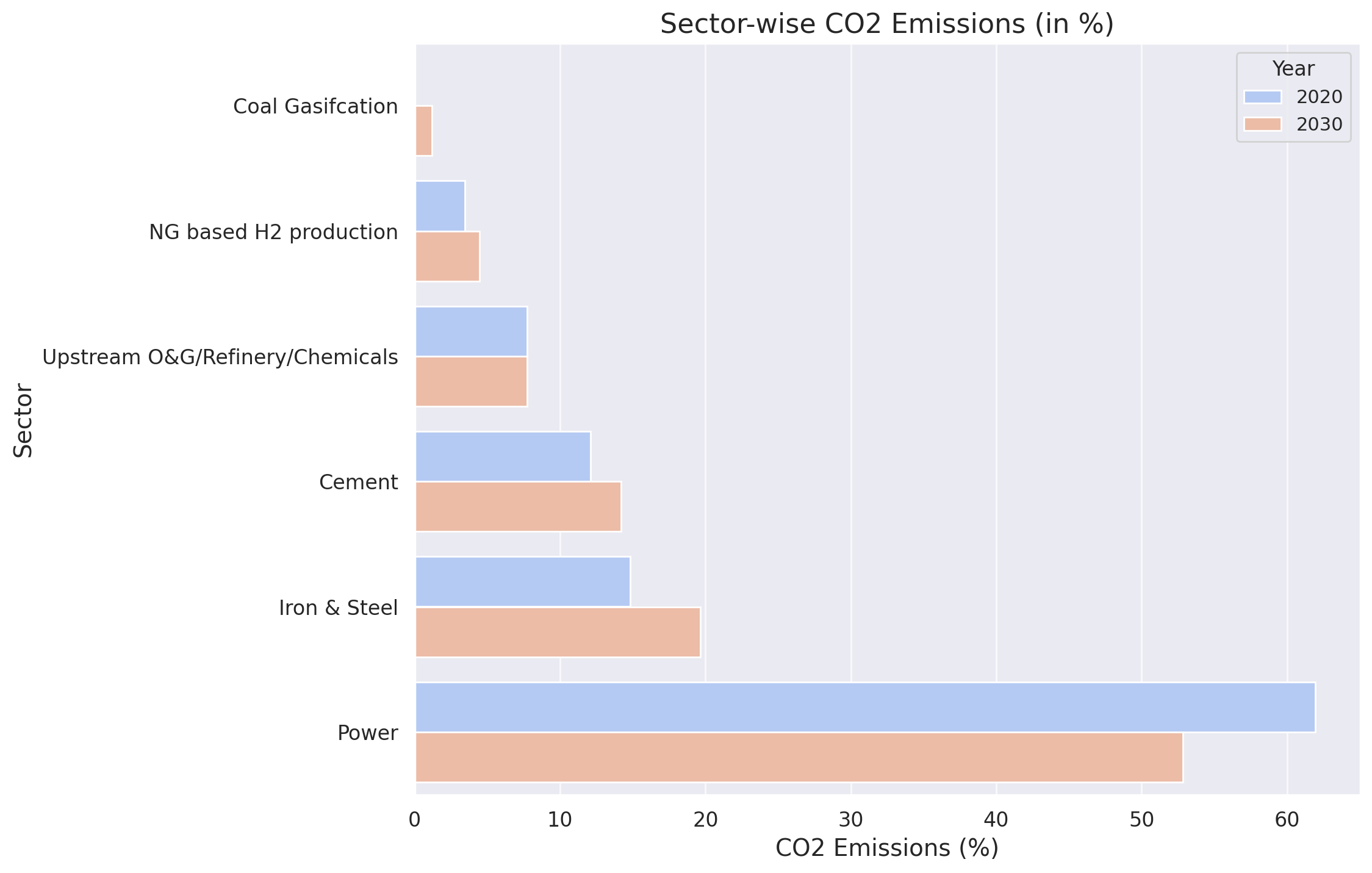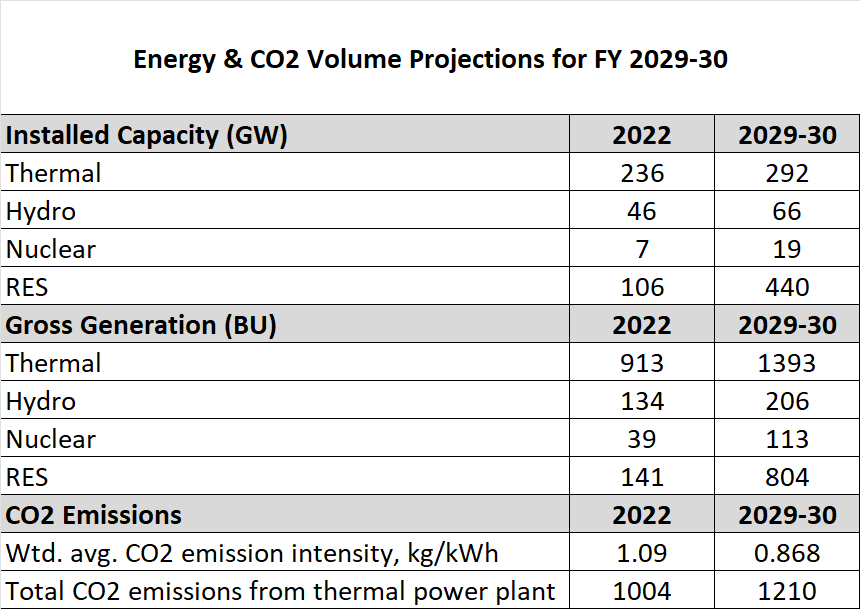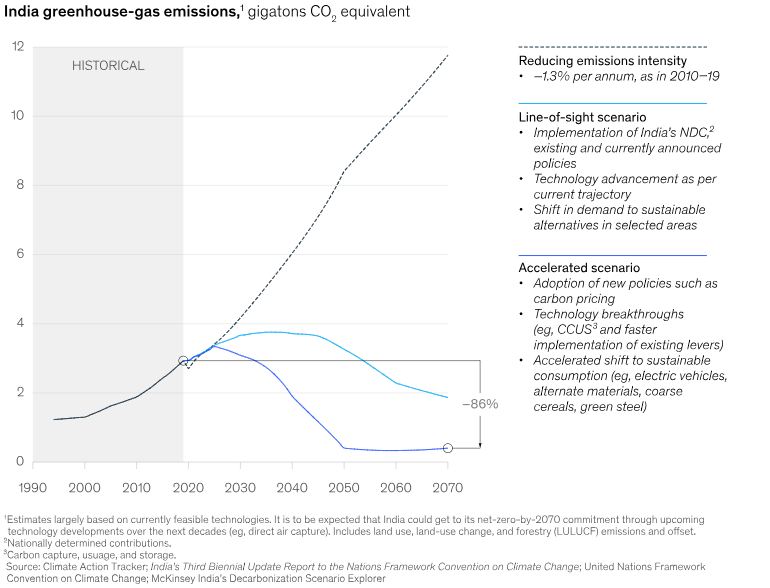Emissions from India's Power Sector: An Overview and the Potential of Carbon Capture
I. Introduction
India, a rapidly developing nation with a burgeoning economy, stands as the world's third-largest emitter of carbon dioxide (CO2). The country's power sector, a critical engine driving this growth, is a significant contributor to these emissions, accounting for approximately 70% of the total. The primary contributor is coal, a resource that India heavily relies on for its electricity generation.

Source:NITI AAYOG
As the world grapples with the escalating crisis of climate change, the spotlight is on technologies that can help mitigate the impact of CO2 emissions. One such promising solution is Carbon Capture. This technology, designed to capture up to 90% of CO2 emissions, reduces overall Carbon footprints for the sector.
This blog post aims to provide an in-depth analysis of India's power sector, its contribution to global CO2 emissions, and the potential role of Carbon Capture in transforming this scenario. We will explore how CCS, if implemented effectively, could help India strike a balance between its developmental goals and environmental responsibilities, ultimately aiding the country in its ambitious quest to achieve net zero emissions by 2070.
II. The Current State of India's Power Sector
Energy use in India has doubled since 2000, with coal, oil, and solid biomass meeting 80% of its demand. As of 2022, the installed capacity of renewable energy (RE) sources, including large hydropower plants, is around 161 GW. However, the abundant availability and lower cost of coal compared to other energy sources make it the preferred choice.
These complexities highlight the intricate dynamics of India's power sector.
III. The Impact of India's Power Sector on Climate Change
India's power sector, primarily reliant on coal, significantly contributes to the nation's CO2 emissions, which directly impact climate change. As the third-largest emitter of greenhouse gases globally, India accounted for 7% of global CO2 emissions in 2019, with the power sector responsible for about 70% of these emissions.
These emissions have far-reaching effects. They lead to global warming, causing melting ice caps, rising sea levels, and an increase in extreme weather events like cyclones, floods, and droughts.
These emissions also contribute significantly to air pollution. The burning of coal releases a host of pollutants, including particulate matter, sulfur dioxide, nitrogen oxides, and mercury. These pollutants can cause severe health issues, such as respiratory illnesses and cardiovascular diseases, and contribute to premature deaths. Additionally, they cause environmental damage, including acid rain, soil and water pollution, and harm to wildlife.
Addressing CO2 emissions from the power sector is thus critical not only for mitigating climate change impacts but also for improving air quality and public health.

Source: IQAir
IV. The Potential of Carbon Capture in India's Power Sector
Carbon Capture and Storage (CCS) is a technology that can play a significant role in reducing Carbon footprints, particularly from large stationary sources such as power plants. It involves capturing carbon dioxide (CO2) emissions produced from the use of fossil fuels in electricity generation and industrial processes, preventing the CO2 from entering the atmosphere.
According to the NITI Aayog report, the installed capacity in India is expected to more than double and reach around 820 GW by 2030 from the existing capacity of around 400 GW. Thermal power (coal + gas) capacity in India is expected to reach 290 GW by 2030. Although the share of thermal capacity is expected to drop from the present 60% to 36% in 2030, thermal power generation is expected to still account for 56% of the total electricity generation in India.

Source: NITI Aayog
Even though the share of installed generation capacity of thermal power plants is expected to drop due to the significant increase in renewable energy capacity, anthropogenic CO2 emissions from the power sector will still contribute to the majority of CO2 emissions in India. The CO2 intensity will also increase in the future with improved plant performance and PLF, the retirement of old facilities, and the operation of super-critical or ultra-super-critical units. Based on the contribution of thermal power plants and their CO2 emission intensity, the total scope 1 emissions from thermal power plants is estimated to be around 1200 mtpa in 2030.
Therefore, the potential of Carbon Capture in India's power sector is immense. It can significantly reduce CO2 emissions from the power sector, which is responsible for the majority of India's CO2 emissions. Moreover, it can help India achieve its 2070 net zero goals.
V. GAS LAB's Role in Promoting Carbon Capture in India
GAS LAB, a leading company in the field of industrial gases, is making significant strides in promoting Carbon Capture. With decades of global experience in application-oriented technology solutions built on the firm foundation of continual in-house and collaborative research, Carbon Capture solutions from GAS LAB are designed to handle a variety of emission profiles.
What sets GAS LAB apart is its ability to retrofit its carbon capture technology into existing plants without disturbing the initial capital investment. This means that power plants and industries can adopt GAS LAB's carbon capture technology without having to overhaul their existing infrastructure. This feature makes it a cost-effective solution for industries looking to reduce their carbon footprint.
Additionally, with Carbon Capture, facilities are able to add additional product, Carbon dioxide in their product portfolio, which can be utilized in various sectors such as Water pH balance, Desalination, Soil pH correction, fire suppression systems, food and process etc. This not only creates industrial products from waste, while mitigating environmental challenges but also makes the Carbon Capture system self sustainable for its operation and maintenance.
GAS LAB's technology has already been successfully implemented in various sectors. These implementations not only demonstrate the versatility of GAS LAB's technology but also its effectiveness in reducing CO2 emissions across different sectors.
VI. The Path to India's 2070 Net Zero Goals
India's commitment to achieving net-zero emissions by 2070 is a significant step towards combating climate change. This ambitious goal necessitates a multi-pronged approach, with Carbon Capture playing a crucial role. Carbon Capture technology can help reduce CO2 emissions from hard-to-abate sectors like power generation, steel, cement, and petrochemicals, which are integral to India's economic growth.
The adoption of carbon capture, along with other measures such as renewable energy expansion and energy efficiency improvements, can significantly reduce India's CO2 emissions. According to the International Energy Agency (IEA), widespread adoption of carbon capture could reduce global CO2 emissions by nearly 20%. In the context of India, the NITI Aayog report suggests that the total scope 1 emissions from thermal power plants alone could be around 1200 million tonnes per annum (mtpa) in 2030. With effective implementation of carbon capture, a significant portion of these emissions could be captured and stored or utilized, thereby helping India move closer to its net-zero goal.
Models and projections indicate that the potential impact of widespread carbon capture adoption on India's CO2 emissions is substantial. For instance, a study by McKinsey suggests that India could reduce its CO2 emissions by up to 45% by 2030 through a combination of measures including carbon capture. Furthermore, the NITI Aayog report projects that the total CO2 emissions from the power sector could be around 1200 mtpa in 2030, indicating a significant potential for carbon capture.

VII. Conclusion
In conclusion, Carbon Capture & Utilization Holds immense potential in addressing the pressing issue of CO2 emissions from India's power sector. As the third-largest emitter of CO2 globally, India's transition towards a low-carbon future is not just a national imperative but a global necessity. The power sector, contributing to a significant portion of the country's emissions, stands as a critical area where carbon capture can make a substantial impact.
The adoption of carbon capture technology can significantly reduce CO2 emissions, aiding India in its ambitious goal of achieving net-zero emissions by 2070. However, realizing this potential requires concerted efforts from all stakeholders. It calls for increased investment in carbon capture technology, fostering innovation, and facilitating research to make this technology more efficient, cost-effective, and scalable.
GAS LAB, with its pioneering work in the field of carbon capture technology, stands at the forefront of this transformative journey. We invite you to explore GAS LAB's innovative solutions that can be retrofitted into existing plants, offering a viable and effective way to reduce CO2 emissions. Reach out to us to learn more about how we can collectively work towards a sustainable and carbon-neutral future.
Together, let's embrace the power of carbon capture and pave the way for a cleaner, greener, and more sustainable India.
Reference Links
(1) https://www.iea.org/reports/india-energy-outlook-2021
(2) https://www.orfonline.org/expert-speak/power-sector-stumbling-block-in-indias-net-zero-journey/
(3) https://www.linkedin.com/pulse/scope-challenges-co2-emission-reduction-indian-power-sector-ray
(6) https://pib.gov.in/PressReleasePage.aspx?PRID=1879865
(7) www.ssgaslab.com
(8) https://www.bbc.com/news/world-asia-india-59125143
(9) India Air Quality Index (AQI) : Real-Time Air Pollution Level